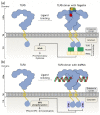Role of TLRs in HIV-1 Infection and Potential of TLR Agonists in HIV-1 Vaccine Development and Treatment Strategies
- PMID: 36678440
- PMCID: PMC9866513
- DOI: 10.3390/pathogens12010092
Role of TLRs in HIV-1 Infection and Potential of TLR Agonists in HIV-1 Vaccine Development and Treatment Strategies
Abstract
Toll-like receptors (TLRs), as a family of pattern recognition receptors, play an important role in the recognition of HIV-1 molecular structures by various cells of the innate immune system, but also provide a functional association with subsequent mechanisms of adaptive immunity. TLR7 and TLR8 play a particularly important role in the innate immune response to RNA viruses due to their ability to recognise GU-rich single-stranded RNA molecules and subsequently activate intracellular signalling pathways resulting in expression of genes coding for various biological response modifiers (interferons, proinflammatory cytokines, chemokines). The aim of this review is to summarise the most recent knowledge on the role of TLRs in the innate immune response to HIV-1 and the role of TLR gene polymorphisms in the biology and in the clinical aspects of HIV infections. In addition, the role of TLR agonists as latency reversing agents in research to treat HIV infections and as immunomodulators in HIV vaccine research will be discussed.
Keywords: HIV-1; TLR agonists; Toll-like receptors (TLRs); innate immunity; latency reversing agents (LRAs).
Conflict of interest statement
The authors declare no conflict of interest.
Figures



Similar articles
-
The Use of Toll-Like Receptor Agonists in HIV-1 Cure Strategies.Front Immunol. 2020 Jun 11;11:1112. doi: 10.3389/fimmu.2020.01112. eCollection 2020. Front Immunol. 2020. PMID: 32595636 Free PMC article. Review.
-
Intracellular TLRs of Mast Cells in Innate and Acquired Immunity.Handb Exp Pharmacol. 2022;276:133-159. doi: 10.1007/164_2021_540. Handb Exp Pharmacol. 2022. PMID: 34505203
-
Toll-like receptors and viruses: induction of innate antiviral immune responses.Open Microbiol J. 2008;2:49-59. doi: 10.2174/1874285800802010049. Epub 2008 May 14. Open Microbiol J. 2008. PMID: 19088911 Free PMC article.
-
Targeting toll-like receptor 7/8 for immunotherapy: recent advances and prospectives.Biomark Res. 2022 Dec 7;10(1):89. doi: 10.1186/s40364-022-00436-7. Biomark Res. 2022. PMID: 36476317 Free PMC article. Review.
-
Nucleic Acid-Sensing Toll-Like Receptors Play a Dominant Role in Innate Immune Recognition of Pneumococci.mBio. 2020 Mar 24;11(2):e00415-20. doi: 10.1128/mBio.00415-20. mBio. 2020. PMID: 32209688 Free PMC article.
Cited by
-
HIV-1 Integrase Inhibition Activity by Spiroketals Derived from Plagius flosculosus, an Endemic Plant of Sardinia (Italy) and Corsica (France).Pharmaceuticals (Basel). 2023 Aug 8;16(8):1118. doi: 10.3390/ph16081118. Pharmaceuticals (Basel). 2023. PMID: 37631033 Free PMC article.
-
ATF4 Signaling in HIV-1 Infection: Viral Subversion of a Stress Response Transcription Factor.Biology (Basel). 2024 Feb 26;13(3):146. doi: 10.3390/biology13030146. Biology (Basel). 2024. PMID: 38534416 Free PMC article. Review.
-
Association of Toll-Like Receptor Gene Polymorphisms with Tuberculosis in HIV-Positive Participants.Epigenomes. 2023 Jul 25;7(3):15. doi: 10.3390/epigenomes7030015. Epigenomes. 2023. PMID: 37606452 Free PMC article.
-
Female Sex Hormones Upregulate the Replication Activity of HIV-1 Sub-Subtype A6 and CRF02_AG but Not HIV-1 Subtype B.Pathogens. 2023 Jun 27;12(7):880. doi: 10.3390/pathogens12070880. Pathogens. 2023. PMID: 37513727 Free PMC article.
-
Toll-like Receptor Response to Human Immunodeficiency Virus Type 1 or Co-Infection with Hepatitis B or C Virus: An Overview.Int J Mol Sci. 2023 Jun 1;24(11):9624. doi: 10.3390/ijms24119624. Int J Mol Sci. 2023. PMID: 37298575 Free PMC article. Review.
References
-
- United Nations Programme on HIV/AIDS . UNAIDS Data 2021. UNAIDS; Geneva, Switzerland: 2021. pp. 4–38.
-
- Barré-Sinoussi F., Chermann J.C., Rey F., Nugeyre M.T., Chamaret S., Gruest J., Dauguet C., Axler-Blin C., Vézinet-Brun F., Rouzioux C., et al. Isolation of a T-Lymphotropic Retrovirus from a Patient at Risk for Acquired Immune Deficiency Syndrome (AIDS) Isolation of a T-Lymphotropic Retrovirus from a Patient at Risk for Acquired Immune Deficiency Syndrome (AIDS) Science. 1983;220:868–871. doi: 10.1126/science.6189183. - DOI - PubMed
-
- Gupta R., Peppa D., Hill A.L., Gálvez C., Salgado M., Pace M., McCoy L.E., Griffith S.A., Thornhill J., Alrubayyi A., et al. Evidence for HIV-1 cure after CCR5Δ32/Δ32 allogeneic haemopoietic stem-cell transplantation 30 months post analytical treatment interruption: A case report. Lancet HIV. 2020;7:e340–e347. doi: 10.1016/S2352-3018(20)30069-2. - DOI - PMC - PubMed
Publication types
Grants and funding
LinkOut - more resources
Full Text Sources
Miscellaneous

